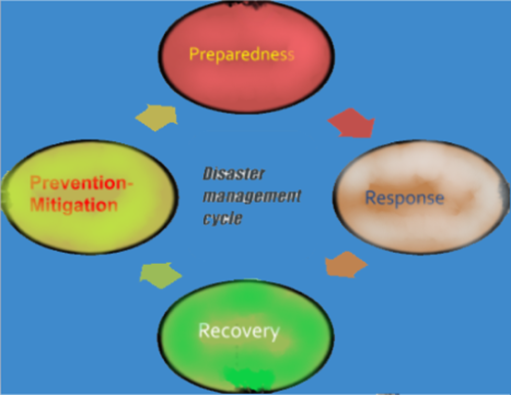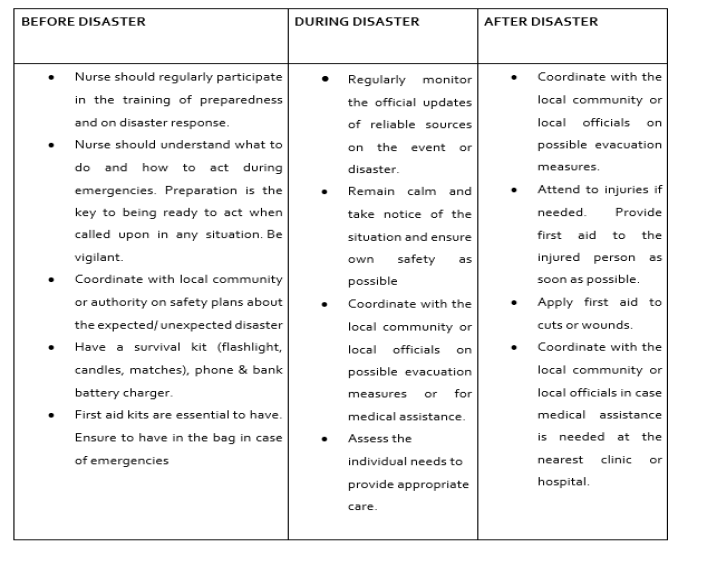
Studerandebloggen/ Student blog
To work as a nurse in disaster area in the Philippines

Author: Jovelyn Bendal Racasag-Niemi, Degree Programme: BS nursing student, Novia UAS
Supervisor(s): Anita Wikberg, RN, RM, PHD Senior lecturer, Novia UAS
Abstract
The Philippines counted as one of the most disaster risk-prone countries in the world. Every year the country suffers several deadly disasters such as earthquakes, floods, volcano eruptions, landslides, and typhoons. Some parts of the country also suffer disasters that are caused by human activities such as war and terrorism. The purpose of this article is to describe nurse competence in managing panic situations, providing first aid to the injured and affected persons, and taking responsibility for difficult situations in the disaster area. The nurse in a disaster area has a big responsibility for providing immediate help to people who are in need.
The role of a nurse is considered essential in connection with preparedness and management at the community, and national levels through planning, education, and providing care during disasters. The nurse must have the competence to act, communicate, and manage difficult situations in the area where the disaster happens. It is also important to stay focus, calm, and always prepared for any situation.
Communication is a vital aspect of a disaster area for a successful operation. It is essential to have an interactive exchange of information about the hazard risk among local government units (LGU), media, and other involved persons in the community.
Introduction
Philippines is one of the countries where different types of disasters occur every year. This is the motivation to write the topic about “To work as a Nurse in a Disaster Area” since the first author is from Philippines and have witnessed several deadly natural disasters in the country. The Philippines is a tropical country that is prone and vulnerable to natural disasters. Natural disasters can be predictable or unpredictable events and can happen at any season or any time of the year. The purpose of this article is to describe nurse competence in managing panic situations in providing first aid and taking responsibility for difficult situations in the disaster area.
Natural disasters or human-made disasters can happen in any part of the world. All kinds of disasters are always frightening, challenging, and catastrophic circumstances. According to the United Nations Office for Disaster Risk Reduction2017, Philippines counted as one of the most disaster risk-prone countries in the world. Due to population growth, change in strategies in land use, migration, environmental degradation, and unplanned urbanization, global climate changes, the cost of economic and social of natural disasters is increasing in the country. Every year the country suffers several deadly disasters such as earthquakes, floods, volcano eruptions, landslides, and typhoons. Some parts of the country also suffer disasters that are caused by human activities such as war or terrorism. A lot of people can be affected by natural or human-made disasters nationwide. People may suffer physical, emotional, psychological, and financial problems caused by the disaster. All kinds of disasters may cause extensive destruction, crucial collateral damage, or loss of lives, poverty, and sickness.
As a nurse working in a disaster or vulnerable area can be challenging and traumatic because any unexpected events can happen in the area. It is vital as a nurse to be prepared and have proper training on how to act when a disaster happens and plan on how to respond to any disasters. The nurse in a disaster area has a big responsibility for providing immediate help and giving first aid or care to people who are in need. Association of Women’s Health, Obstetric & Neonatal Nursing Board of Directors (2011), emphasizes that women and infants are a substantial and vulnerable population that should be given special consideration in a disaster situation. Any calamities in the area, preparedness, cooperation, and open communication of everyone involved are the keys to have successful operations during the disaster.
Disaster
Nikita (2020) defines the disaster as a sudden, accidental phenomenon of great magnitude that causes substantial damage to life and property. Natural or human-made disasters can always affect communities or countries. It can disrupt essential services such as food, electricity, and water supplies, communications, housing, transportation, sanitation, loss of life, disease, injury, loss of social and economic disruption, and environmental degradation. It can also affect people´s well-being and may increase the proportion of people living in poverty.
A disastrous phenomenon can occur worldwide. Some disasters can be predictable, and some are unpredictable events. It can seriously damage the place or society and creates a dilemma that can cause economic or environmental losses that exceed the society’s ability to cope using its resources. According to Zibulewsky (2001), a substantial disaster happens daily globally, and the need for natural disasters, international assistance occurs weekly. The property damages attributed to disasters is 3 million deaths and $50 billion over the past 20 years.
According to Natural Homeland Security (2020), natural disasters occur both seasonally and without warning. All types of severe weather have the potential to create a significant threat to human health and safety, dangerous infrastructures, damage to properties, and security of a community or the country. According to UN News (2015), the UNISDR issued a new report that 90 percent of major disasters caused by 6,457 recorded storms, floods, droughts, heatwaves, and other weather-related circumstances over the last 20 years. Worldwide, around 60,000 people die every year in a natural disaster. The majority case of death is caused by building collapse in earthquakes, and mostly it happens in developing countries (Kenny, 2013).
Natural disasters in the Philippines
According to the US Embassy Philippines (2020), the Philippines consider as one of the most high-risk countries in the world for experiencing natural disasters. The possible natural disasters are typhoons, floods, mudslides, earthquakes, and volcanic eruptions. Geographically, the Philippines is a tropical country with more than 7,100 islands located within the circum-Pacific seismic belt and this makes the Philippines a disaster-prone country (Hidalgo 2020).
The all-year-round temperature of this country is quite the same. The significant difference is it can be relatively dry for six months, and for the other six months, it can be wet or rainy. The country´s climate divided into two major seasons: the rainy season from the month of June to November and the dry season from December to May. The dry season sub-divided into the cold and dry season from the month of December to February and the dry and hot season from March to May (Government of the Philippines, 2020).
Typhoon
According to the report of Brown (2013), an average of eight or nine tropical storms makes landfall in the Philippines each year. The most prevalent hydro-meteorological hazards in the Philippines are typhoons or tropical storms accompanied by heavy rain or strong winds that may result in storm surge, flood, and landslides (National Disaster Risk Reduction and Management Plan 2011‐2028). Philippine typhoon advisory uses public storm warning signals based on intensity to warn the public about the incoming weather disturbances and typhoon intensity. The signal number is based on the tropical storm or typhoon´s intensity, size of circulation, and the forecast direction and speed. The changes in magnitude, movement, size of the circulation of the tropical storm also determine the changes of the public typhoon warning signal in a specified area (Official Gazette, 2020).
Floods
The rainy season in the Philippines can bring floods and a variety of diseases in some areas. The affected areas may face a severe shortage of food and drinking water, transportation and may cause loss of lives and damage to properties. People may get various diseases and infections caused by bacteria like E Coli bacteria and Leptospira. According to the Centers for Disease Control and Prevention (2020), E. coli (Escherichia coli) are bacteria found in the intestines of people and animals, contaminated foods, and the environment. Most types of bacteria are harmless, but some strains can cause stomach cramps, bloody diarrhea, and vomiting. Leptospirosis is a bacterial infection that humans and animals can get when cut or wound in the skin is exposed to contaminated water. It can lead to kidney damage, kidney failure, meningitis, respiratory distress, and even death if left untreated (Centers for Disease Control and Prevention, 2019).
Landslide
Landslides are a common phenomenon in the Philippines. Heavy rainfalls have often triggered landslides in the prone area. Considerably, mining activities and illegal logging are the contributing factors to landslides. Deforestation in the Philippines is the significant reason behind flooding, rapid soil erosion, acute water shortages, and mudslides that have proved costly to the environment, properties, and also in people’s lives (Bengwayan, 2020).
Volcano eruptions
During and after the eruption the mud and ashes can scatter everywhere which causes massive disturbance to people and the community The Volcanology Institute warns people that fine ashfall can cause breathing problems to people, especially among young children and the elderly (Neuman, 2020).
Earthquake
An earthquake can cause damage to infrastructures when it strikes, and it can cost a lot to repair or reconstruct the damage to infrastructure in the area. Kenny (2013) stated that the majority of earthquake-related deaths occur from the buildings' collapse in earthquakes. According to the Philippine Institute of Volcanology and Seismology (PHIVOLCS) (2020), earthquakes have two types the volcanic and tectonic earthquakes. The volcanic earthquake is influenced by rising lava or magma beneath active volcanoes, and the tectonic earthquake created by a sudden movement along faults and plate boundaries. When an earthquake strikes in the Philippines, tsunamis can be one of the considerations when the country is surrounded by water. Meanwhile, people should be vigilant and recognize early warning signs of a tsunami in particularly those who live in coastal areas.
Human-made disasters in Philippines
Human-made or man-made disasters are the results of human intention, error, or negligence involving a failure of a man-made system (US legal, 2019). War and terrorism can affect human life, economy, society, and the environment. According to UNICEF Philippines (2018), risks for children affected by wars are rising, especially for young children becoming malnourished and school-age children being unable to return to school. The threat of terrorism affects people nationwide.
War on drugs
The Philippines President has declared a war on drugs since taking office on 30 June 2016. President Rodrigo Duterte admitted that the illegal drug trade in the country has worsened despite the government’s persistent effort against its proliferation (Regalado, 2019). Based on the United Nations report, possibly tens of thousands of people have been killed in the war on drugs since mid-2016. Illegal drugs can destroy human life and can affect the financial status, family dynamics, and stability of the household (Asia politics, 2020).
Terrorism
The threat of terrorist acts within the Philippines has taken a bloody evolution from kidnappings, killings, and armed attacks in the past. The improvised explosive devices in the last decade have risen, and also the deadly ramp-up of suicide bombings (Mendoza and Romano, 2020). In 2017, the conflict broke out between the government of the Philippines and armed groups in Marawi city, on the southern Philippines, in the island of Mindanao and displaced residents at the peak of the conflict. The armed conflict between the government forces of the Philippines and pro-ISIS militants in Marawi has forcibly relocated 98 percent of the overall population of the city, and the residents from nearby municipalities as well, who were forced to leave due to severe food shortage and constriction of local economies (The UN Refugee Agency, 2020).
Nurse competence
According to the World Health Organization (2020), nurses, midwives, and other healthcare workers play a significant role in caring for people everywhere, including in times of outbreaks and settings that are vulnerable or in conflict areas. Nurses are in the frontlines of the response before, during, and in the aftermath of the disaster. They also play a key role in coordinating and implementing a response plan aspect when natural or human-made disaster happens in the area.
According to Hassmiller and Stanley (2017), in disaster management cycle includes four stages (1) prevention/mitigation; (2) preparedness; (3) response; and (4) recovery. The aim of disaster management is to avoid, or reduce the potential injury or losses from hazards, assure immediate and proper assistance to victims of disaster and acquire fast and effective recovery.

Figure 1: An illustration of four stages of disaster management cycle.
The competence of a nurse for immediate response is essential during vulnerable situations or calamity crises. The role of nurses is to act immediately and be able to provide first aid or treatment to injured and affected persons in the area during and aftermath of a disaster. In all circumstances, it is important to stay focus, calm, and be prepared. The level of preparedness should always be present during emergencies. The nurse must have the capability to manage and assess the situation in the area and be able to provide first aid to the injured or affected individuals. A nurse working in a disaster area or at a remote place should consider and find other solutions to handle the difficult situation when there is a shortage or limitation in medical supplies, equipment, and utilities.
Disaster is possible to happen anywhere and anyone can experience it, and the potential outcome is always uncertain. Perhaps, in a disaster or vulnerable area, especially in a remote place, the nurse could educate people and give awareness about the possible effect and how to prevent or decrease the effects of it, physically, emotionally, psychologically, and financially as well. Raising awareness to the population who are in disaster-prone areas can lessen the panic situation, injury, sickness, and death. By educating it can improve an individual´s awareness and help them take precautions. For instance, people must be aware of the possible disease from contaminated water during the flood event.
The presence of the nurse in the disaster area is essential to provide care and comfort to people. However, it can be challenging for the nurse working in the area of disaster to assist and provide first aid and medication to injured individuals during and in the aftermath of the disaster when resources are limited like medical supplies. In any possible way, the nurse must stay calm and focus. Beforehand, the nurse must be aware of how to act and handle the emergency when a disaster occurs unexpectedly. As a part of the medical team, the nurse needs to respond quickly to save lives. The nurse would be able to identify the health status of the patient by doing a careful assessment that will need.
According to the Commission of Audit (2020), the U.S. Government Accountability Office emphasized the three primary elements the leadership, capabilities, and accountability in preparing for, responding to, and recovering from any dreadful disasters. In terms of leadership and ability, and accountability, the nurse needs to have competence in managing panic situations in providing first aid and taking responsibility for difficult situations.
Disasters preparedness plan
Disaster preparedness is the knowledge and capacities developed by governments, individuals, professional response, recovery organizations, and communities to effectively predict the response to, and recover from the impacts of current hazard or conditions or approaching events (Commission on Audit, 2020). Perhaps, developing countries are vulnerable to disasters as they may not have disaster preparedness systems in place and maybe poor governance, higher levels of poverty, inequalities, and less access to resources and assets.
However, the Philippines government has progressed in raising the people’s awareness on the sudden impact of disasters on the population, community, and economy by integrating the natural hazard risks in its plans, strengthening institutions, and implementation projects like early warning systems, improving weather forecasting and strengthening disaster response (Commission on Audit, 2020). The impacts and losses can be substantially reduced in times of disaster if individuals, authorities, and communities in danger-prone areas are well prepared, ready to act, and provide the knowledge and capacities for effective disaster management.
A nurse in a disaster or vulnerable area needs to focus on different activities that need to be implemented to ensure proper, safe, and timely disaster response operation. In catastrophic circumstances, communication is the key to have a successful operation. It is essential to have an interactive exchange of information about risks among local government units (LGU), media, and other involved persons in the community. The skills and knowledge to effectively respond to disasters among nurses remain inadequate despite many locally and internationally measure that have been made (Labrague, Yboa, & McEnroe-Petitte, 2015). Therefore, it is essential for nurses in disaster areas to actively participate in actual disaster events training, drills training, and further seminars, particularly to disaster preparedness. In table 1 below are some guidelines for nurses working in a disaster area.
Table 1: Guidelines for nurses working in the disaster area in the Philippines

Conclusion
Some developing countries may struggle with not having a precise plan regarding disaster preparedness. However, Philipines has improved in raising awareness to the public regarding how to handle difficult situations during calamities (Commission on Audit, 2020). The nurse plays an essential role in responding to the disaster phenomenon. Therefore, the nurse should always have proper updated training on how to act and manage the situation during calamities. In connection with the nurse´s roles, preparedness and management are considered essential. Nurses must have good communication and understanding, competence, and good coordination and follow a disaster preparedness plan to help the operation properly, fast, and safe during the disaster.
References
- Association of Women’s Health, Obstetric & Neonatal Nursing (AWHONN) Board of Directors, 2011. The Role of the Nurse in Emergency Preparedness. JOGNN Journal of Obstetric, Gynecologic & Neonatal Nursing https://doi.org/10.1111/j.1552-6909.2011.01338.x (Accessed 10.9.2020)
- Brown, S. 2013. The Philippines Is the Most Storm-Exposed Country on Earth. Time philippines-is-the-most-storm-exposed-country-on-earth. (Accessed 2.8.2020)
- Center for Disease Control and Prevention 2019 https://www.cdc.gov/leptospirosis/index.html (Accessed 12.8.2020)
- Centers for Disease Control and Prevention, 2020. E. coli (Escherichia coli) https://www.cdc.gov/ecoli/index.html (Accessed 25.10.2020)
- Asia politics, 2020. Near impunity’ for drug war killings in Philippines, UN report says. CNBC cnbc.drug-war-killings-in-philippines-un-report. (Accessed 20.9.2020)
- Commission on Audit, 2020, Disaster Management Practices in the Philippines: An Assessment p. 39 & 40. https://www.coa.gov.ph/disaster_audit/doc/National.pdf (Accessed 2.9.2020)
- Government of the Philippines (GOVPH), 2020. Climate of the Philippines http://bagong.pagasa.dost.gov.ph/information/climate-philippines (Accessed 10.9.2020)
- Hassmiller, S.B. & Stanley, S.R. 2017. Public Health Nursing and the Disaster Management Cycle. Nurse KeyFastest Nurse Insight Engine public-health-nursing-and-the-disaster-management-cycle (Accessed 12.19.2020)
- Kenny, C. 2013. Why Do People Die in Earthquakes? The Costs, Benefits and Institutions of Disaster Risk Reduction in Developing Countries https://doi.org/10.1596/1813-9450-4823 (Accessed 20.9.2020)
- Hidalgo F. 2020. Philippines prone to natural disasters. Sunstar Davao. https://www.sunstar.com.ph/article/1817401 (Accessed 10.8.2020)
- Homeland Security 2020. Natural Disaster.https://www.dhs.gov/natural-disasters. (Accessed 10.9.2020)
- Labrague, L. Yboa, B.C & McEnroe-Petitte, D. (2015). Disaster Preparedness in Philippine Nurses. Journal of Nursing Scholarship. 47.
- Disaster_Preparedness_in_Philippine_Nurses. (Accessed 10.9.2020) Mendoza R.U. & Romano D.L. 2020The Philippines Anti-Terrorism Act: Who Guards the Guardians? The Dipomats. the-philippines-anti-terrorism-act-who-guards-the-guardians. (Accessed 20.9.2020)
- National Disaster Risk Reduction and Management Plan (NDRRMP) 2011‐2028 asia/documents/dm_information/Philippines. (Accessed 9.9.2020)
- Neuman, S. 2020. Volcanic Eruption In Philippines Causes Thousands To Flee. NPR. volcanic-eruption-in-philippines (Accessed 20.9.2020)
- Nikita, 2020. Natural and Man-Made Disaster and their Impact on the Environment.natural-and-man-made-disaster-. (Accessed 20.8.2020)
- Official Gazette, 2020. THE PHILIPPINE PUBLIC STORM WARNING SIGNALS the-philippine-public-storm-warning-signals/ (Accessed 6.9.2020)
- Philippine Institute of Volcanology and Seismology (2020). Introduction to Earthquake. Department of Science and Technology phivolcs.dost.gov.ph earthquake (Accessed 7.7.2020)
- Regalado, E. 2019. Duterte: Philippines drug situation has worsened. The Philippine Star Philstar.com/headlines-philippines-drug-situation-has-w. (Accessed 8.10.2020)
- The UN Refegee Agency, 2020. Marawi Crisis. UNHCR, Philippines. https://www.unhcr.org/ph/marawi-crisis (Accessed 9.8.2020)
- UNICEF, 2018. Marawi children still at risk 1 year on from conflict—UN children’s agency advocates for wider Lanao del Sur recovery strategy to ensure children’s safety and well-being unicef.org/philippines/press-releases/marawi-children. (Accessed 6.8.2020)
- United Nations News. 2015. UN reports find 90 per cent of disasters are weather-related UN organization report (Accessed 26.10.2020)
- United Nations Office for Disaster Risk Reduction 2017. Regional Office for Asia and Pacific. Disaster-prone Philippines step up urban resilience.disaster-prone-philippines-steps-urban-resilience. (Accessed 8.9.2020)
- US Embassy Philippines 2020. Disaster Preparedness. usembassy.disaster-preparednesshilippines. (Accessed 20.8.2020)
- US legal, 2019. Human-Made Disaster Law and Legal Definition https://definitions.uslegal.com/h/human-made-disaster. (Accessed 26.10.2020)
- World Health Organization, 2020. Voices of Nurses and Midwives in the Philippines who.int/philippines/news/feature-stories. (Accessed 2.9.2020)
- Zibulewsky J. 2001. Defining disaster: the emergency department perspective
- https://www.ncbi.nlm.nih.gov/pmc/articles/PMC1291330/ (Accessed 20.9.2020)
List of figure
- Figure 1: Four stages of disaster management cycle.
Studerandebloggen
Ansvarsfriskrivning: Författaren/författarna ansvarar för för fakta, möjlig utebliven information och innehållets korrekthet i bloggen. Texterna har genomgått en granskning, men de åsikter som uttrycks är författarens egna och återspeglar inte nödvändigtvis Yrkeshögskolan Novias ståndpunkter.
Disclaimer: The author(s) are responsible for the facts, any possible omissions, and the accuracy of the content in the blog.The texts have undergone a review, however, the opinions expressed are those of the author and do not necessarily reflect the views of Novia University of Applied Sciences.